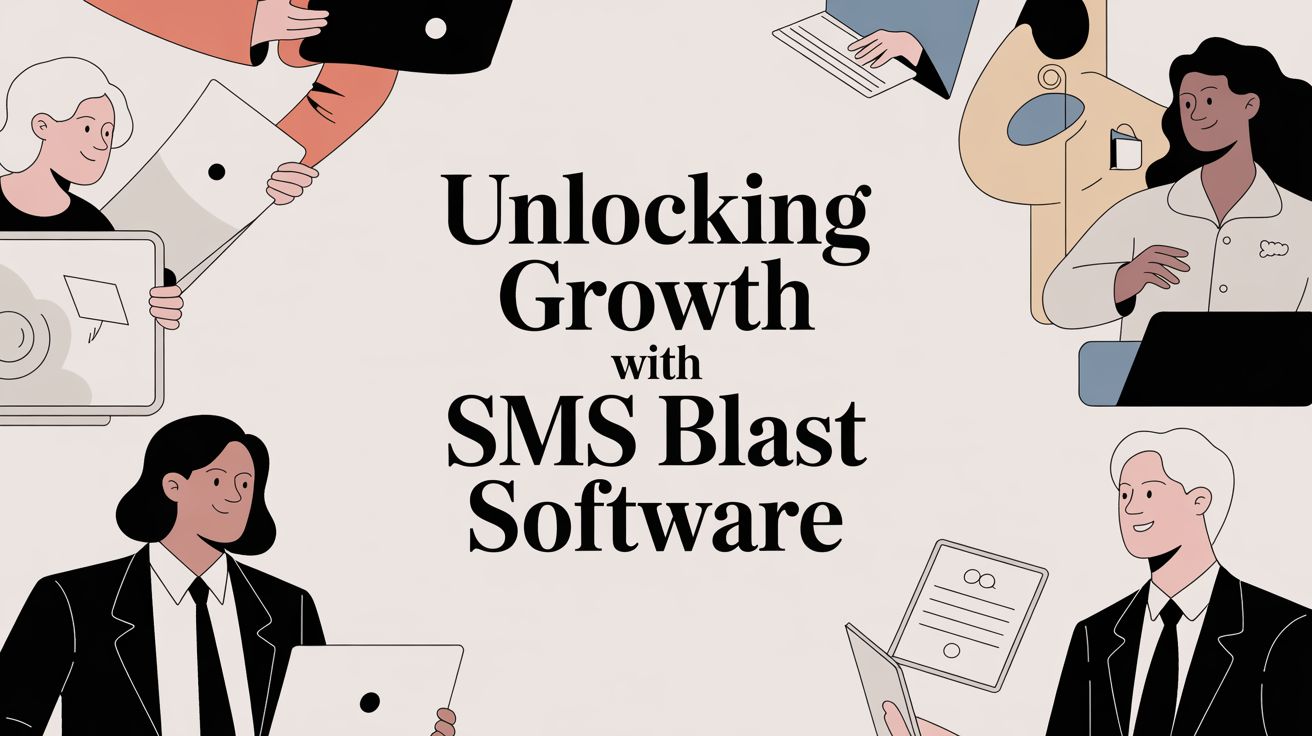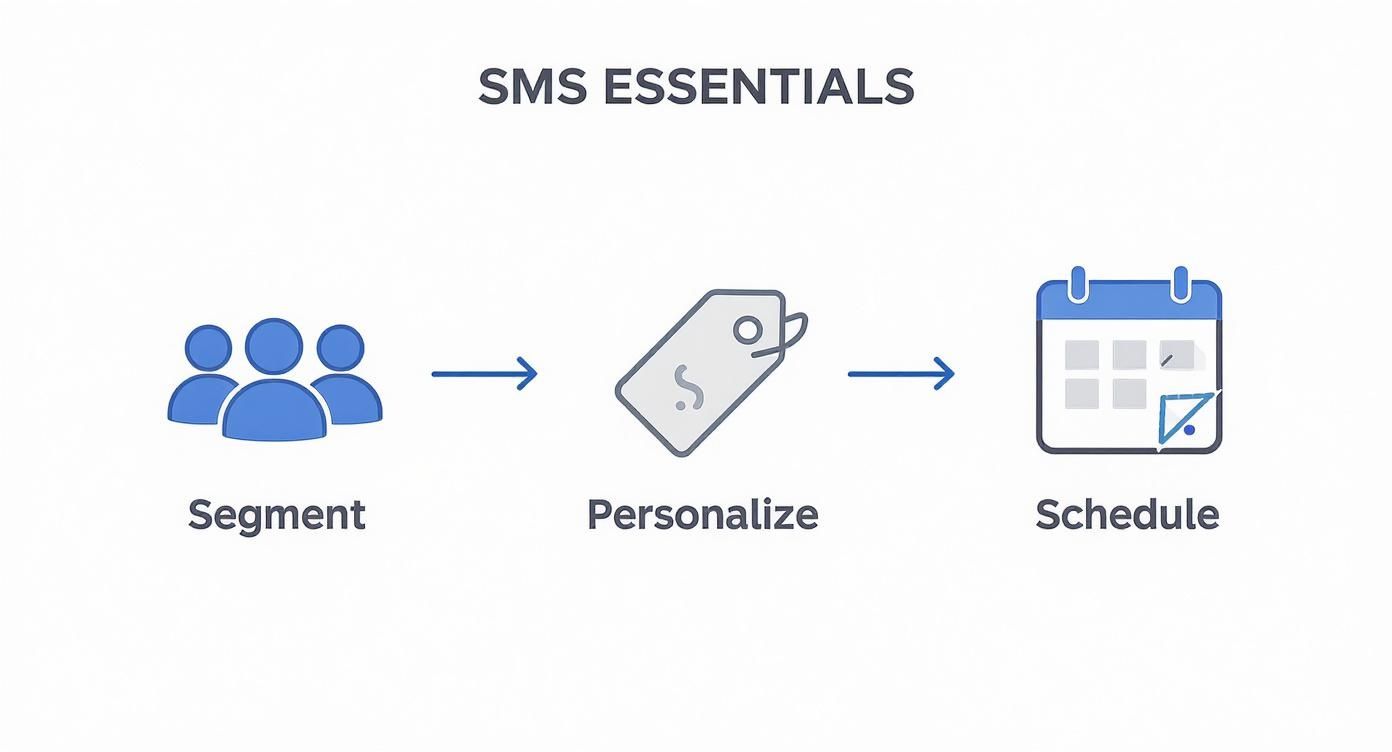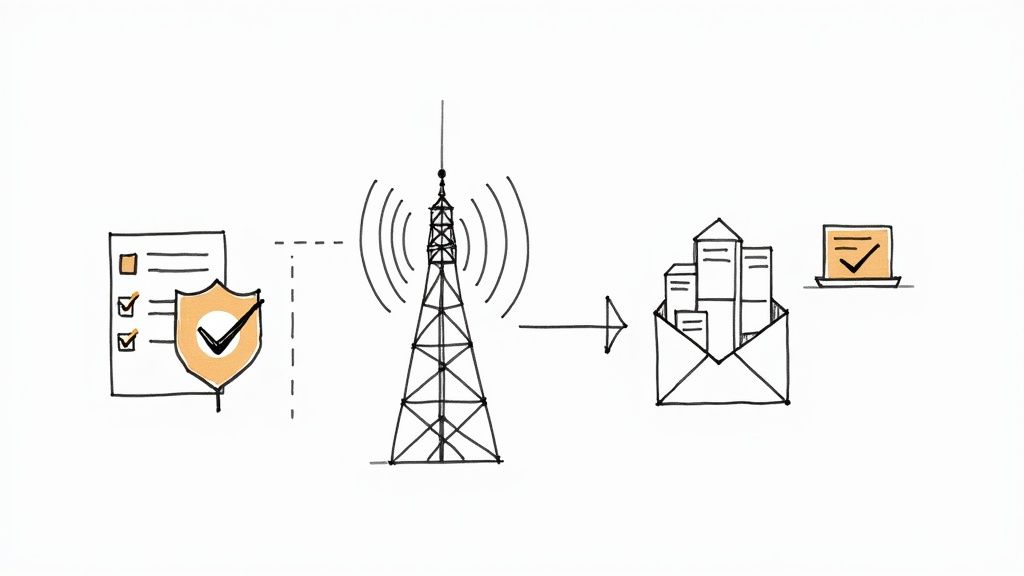See a Demo
You're just one step away from seeing Call Loop in action.
Enter your information below to watch a demo right now.

SMS blast software is your secret weapon for sending targeted text messages to thousands of customers all at once. Think of it as a way to have a one-on-one conversation, but on a massive scale, cutting right through the marketing noise everyone else is making.
Picture yourself trying to get a message to everyone in a packed stadium. You could shout through a giant speaker, sure. But what if you could whisper a personalized note directly into each person's ear instead? That’s the real power behind SMS blast software. It turns mass communication into something that feels personal and meaningful.
This technology is a big deal because it delivers messages that almost always get opened—a feat that's practically unheard of in crowded channels like email. The core idea is simple: send messages out to tons of people without losing that personal touch that builds genuine customer relationships. This is how you drive serious engagement and, ultimately, growth.
Unlike social media feeds or email inboxes, SMS marketing puts your message right where you know your customers are looking: their phone's native messaging app. There are no tricky algorithms to beat or spam filters to dodge. This direct line is what makes it so incredibly effective.
Here’s a quick look at just how much more engaging SMS is compared to other channels.

The data doesn't lie. SMS messages boast an incredible open rate of 98%, completely dwarfing email's average of around 20%. That kind of visibility guarantees your offers, updates, and reminders actually get seen.
The demand for this kind of direct mobile communication has fueled some incredible industry growth. The global SMS marketing software market was valued at USD 10.5 billion and is projected to skyrocket to USD 48.2 billion by 2031, growing at a compound annual rate of 23.08%. This boom shows just how important marketing automation has become, especially with affordable cloud-based platforms making it accessible to everyone. You can dig into more insights about the SMS software market over on verifiedmarketresearch.com.
The bottom line? SMS gives you a direct, personal, and immediate connection to your audience. When you get it right, it can easily become your most powerful tool for building loyalty and driving revenue. For a deeper dive, check out our guide on the 6 steps to a successful SMS marketing campaign.
The real power of any solid SMS blast software isn't just about hitting "send." It’s the whole toolbox of features that turns simple texts into a serious marketing engine. Getting a handle on these core features is the first step in moving from generic announcements to meaningful conversations that actually drive revenue.
At its most basic, the software needs to crush bulk SMS and MMS messaging. This is the core function—the ability to send one message to a huge list of people all at once. Think of it as your brand's megaphone for announcing a flash sale or a critical update to your entire audience in seconds.
But just blasting the same message to everyone is old-school thinking. This is where the smarter tools come into play, starting with how you manage and group your subscribers.
Great SMS marketing feels like a one-on-one conversation, not a robot shouting into the void. The best platforms make this happen with powerful segmentation and personalization tools that treat customers like people, not just numbers on a spreadsheet.
List segmentation is all about slicing your main audience into smaller, more focused groups based on what they have in common. For instance, a clothing brand could create segments for:
Doing this ensures every message lands with relevance, which massively boosts its impact and keeps people from hitting unsubscribe. It’s the difference between getting a generic flyer and a handwritten invitation.
The goal is to send the right message to the right person at the right time. Segmentation and personalization are the tools that make this possible, turning a simple text blast into a tailored experience for each recipient.
Once you know who you're talking to, scheduling and automation let you deliver your message with perfect timing. You can schedule a promo blast to go out right when people are most likely to be shopping, or you can set up automated "drip" campaigns that trigger based on what a customer does.
For example, an e-commerce store can automatically send a text when someone leaves items in their shopping cart, giving them a gentle nudge to finish their purchase. This feature works 24/7 in the background to claw back sales you might have otherwise lost—all without you lifting a finger. For a deeper dive into these capabilities, you can check out the features of a great SMS broadcast service to see how it all works in practice.
Finally, two-way messaging transforms your SMS channel from a monologue into a dialogue. It lets customers reply directly to your messages to ask questions, get help, or give feedback. This is absolutely critical for building real relationships and offering top-notch customer service, making your brand feel accessible and trustworthy.
To put it all together, here's a quick rundown of the essential features and why they matter for your business.
Looking for these core functionalities ensures you’re not just getting a tool to send texts, but a complete platform designed to grow your business and build lasting customer loyalty.
Getting your hands on powerful SMS blast software is just the start. The real magic—and where you’ll see the biggest returns—happens when you create campaigns that people actually want to get and act on. This is where we move past generic, one-size-fits-all blasts and get into the art of crafting short, compelling messages that get real results.
It all begins with the copy. You’ve only got 160 characters to make an impact, so every single word has to pull its weight. Your message needs to be instantly clear, offer obvious value, and create a little urgency without sounding like a pushy salesperson. Think of it as a friendly tap on the shoulder, not a disruptive shout.
Turning a great idea into a profitable campaign requires a solid process. This visual breaks down the core workflow that every successful SMS campaign follows.

As you can see, segmenting your list, personalizing the message, and scheduling it for the perfect time aren't just suggestions—they're the pillars of effective SMS marketing.
A single text is fine, but a connected series of messages? That’s where you build relationships. Good campaign flows nurture subscribers from their very first signup to their latest purchase, building trust over time.
Here are a few automated campaigns you should absolutely have running:
The best SMS marketing feels less like a broadcast and more like a conversation that unfolds over time. By designing intentional campaign flows, you guide customers through their journey with your brand, providing value at every single touchpoint.
Every single message you send needs a purpose, and that purpose is driven by your call-to-action (CTA). Your CTA has to be direct, crystal clear, and simple to act on from a phone.
Vague instructions like "check out our site" just don't cut it. You need specific directives like "Tap to shop the sale: [link]". Using shortened links is key here, both to save precious character space and to make sure you can track every click. For more hands-on tips, our guide on how to send a mass text breaks down message structure in more detail.
Finally, never, ever stop testing. Use A/B testing to play with different copy, offers, and send times. Does your audience respond better to a 20% off discount or a $10 off coupon? Do they engage more in the morning or the evening? The analytics in your SMS blast software hold the answers, letting you constantly sharpen your approach and squeeze more value out of every campaign.
Trust is the bedrock of any marketing channel, and with SMS, it’s completely non-negotiable. Texting people who haven't explicitly asked to hear from you isn't just a clumsy move—it's illegal. Getting the rules of the road right from the start means your campaigns are effective, ethical, and built to last.
More importantly, it protects your brand and your bottom line from some seriously scary penalties.

The big one you need to know in the United States is the Telephone Consumer Protection Act (TCPA). Think of it as the official rulebook protecting people from spammy, unwanted calls and texts. Breaking TCPA rules can get expensive, fast. We're talking fines from $500 to $1,500 per message. That kind of mistake can sink a business.
At the very heart of the TCPA is one simple idea: consent. Before you send a single marketing message with SMS blast software, you absolutely must have Prior Express Written Consent (PEWC).
This is a fancy way of saying someone has to take a clear, deliberate action to sign up. They might check an opt-in box on a web form or text a specific keyword to your number. The key is, they have to initiate it.
You can't bury permission in the fine print of your terms and conditions. You can't just assume that because someone bought something from you, they want your texts. The user has to know exactly what they’re signing up for.
"Consent is technically good until revoked. However, it’s important to note that this isn’t always straightforward. State-specific laws might place temporal limits on consent validity."
This is why clean lists and clear opt-out instructions are so critical. Every single promotional text must give subscribers an easy out, like replying with "STOP" or "UNSUBSCRIBE." And when they do, you have to honor that request immediately. No exceptions.
Staying on the right side of the law is just one piece of the puzzle. You also need to make sure your texts actually get delivered. Mobile carriers are constantly filtering for spam, and a bunch of factors determine if your message hits the inbox or gets blocked. This is what we call deliverability.
Here are a few things that can make or break your delivery rates:
By focusing on getting clear consent and keeping your sender reputation clean, you’ll build an SMS program that respects your customers, sidesteps costly legal trouble, and actually gets your messages where they need to go.
Let's be clear: there's no single "best" SMS platform out there. The real goal is finding the one that fits your business like a glove. This decision is a big deal, especially when you see companies are now dedicating nearly 18.76% of their marketing budgets to SMS. That's a huge vote of confidence in its power to engage. You can see more on how SMS is grabbing a bigger piece of the pie over at omnisend.com.
A little homework upfront will make sure your investment actually pays off. Don't just look at the sticker price; dig into the pricing models. Are they offering a flexible pay-as-you-go plan, or are you getting locked into a monthly subscription with a fixed number of credits? A small shop just dipping its toes into SMS will love the pay-per-message freedom, while a bigger operation might save a ton with a high-volume monthly plan.
Your business is going to grow, and your software needs to be ready for the ride. Ask yourself this: can this platform handle a list ten times bigger than what I have now without the price exploding or the performance tanking? Scalability is all about making sure you don’t have to jump ship right when your marketing is finally hitting its stride.
Just as important is how well it plays with your other tools. The right software should feel like a natural extension of your existing tech stack.
As you look at different SMS blast software, it helps to see where it fits in the larger marketing automation world. You can also use this perspective to explore a wider array of marketing automation software platforms. This gives you the context to see how text messaging can work hand-in-hand with your other efforts.
Finally, never, ever underestimate the value of a clean interface and solid customer support. If the software is a clunky, confusing mess, your team just won't use it to its full potential. A great platform makes complicated tasks—like segmenting a list or building out an automated workflow—feel simple and straightforward.
A powerful tool is only useful if you can actually use it. Look for a platform with a minimal learning curve, clear documentation, and a responsive support team that’s available when you run into trouble.
Before you sign on the dotted line, take full advantage of any free trials. This is your best shot to get your hands dirty and see if the platform really clicks with your budget, your team's technical skills, and your ultimate marketing goals.
Launching a campaign is just the beginning. The real work starts when the messages go out, and you have to figure out if your efforts are actually hitting the mark. This is where the data comes in. Measuring the right key performance indicators (KPIs) is what separates wild guessing from building a predictable, data-driven marketing machine.
Think of these metrics as your campaign’s vital signs. They tell you what's working, what's falling flat, and exactly where you can tighten the screws for better results. If you can't track your performance, you can't prove the value of your SMS program. And honestly, proving your return on investment depends entirely on your ability to measure marketing attribution and prove ROI.
Your software's dashboard is probably flooded with numbers, but you don't need to track everything. A few core metrics tell most of the story. Keeping a close eye on these will give you the clearest picture of your campaign's health.
It's not enough to just look at these numbers; you have to understand what they're telling you. A low CTR could mean your offer is weak. A high unsubscribe rate might be a sign you're being too aggressive. Every metric is an insight you can use to build smarter campaigns next time.
When you look at the raw numbers, SMS marketing blows most other channels out of the water. A typical CTR for an SMS campaign hovers between 20-35%—leagues ahead of email. The speed is insane, too, with 98% of texts being read within just two minutes. If you want to dig deeper, you can find more of these powerful SMS marketing statistics on llcbuddy.com. This kind of engagement is exactly why getting a handle on your metrics is so critical for growth.
Jumping into the world of text message marketing always brings up a few questions. Let's tackle some of the most common ones we hear from businesses just like yours.
Think of an SMS blast as casting a wide net. It’s a single message you send out to a large, general audience all at once. It’s great for big announcements that apply to everyone on your list.
A targeted campaign, on the other hand, is more like precision fishing. You send specific messages to smaller, segmented groups based on things like their interests, where they live, or what they’ve bought before.
For example, a blast might shout out a store-wide sale to every single subscriber. A targeted campaign would quietly message only your VIP customers about an exclusive early-access event just for them.
Software costs can swing pretty wildly depending on the features you need and how many messages you plan to send.
Many platforms use a tiered monthly subscription model, often starting around $25-$40 per month for a certain number of text credits. You'll also find pay-as-you-go options, which are perfect for businesses whose texting needs change from month to month.
Absolutely. Most modern SMS platforms are built to play nice with the other software you already use.
Integrations are common for e-commerce stores like Shopify, CRMs like HubSpot, and literally thousands of other apps through services like Zapier. This is the key to automating powerful workflows, like automatically sending a reminder to someone who left items in their shopping cart.
The single biggest mistake you can make is sending messages without getting clear, explicit consent first. This doesn’t just break trust—it violates critical regulations like the TCPA. The fines are severe, and the damage to your brand's reputation can be even worse. Always, always prioritize a clean, opted-in subscriber list.
Another common pitfall is just sending out generic, impersonal content. If you don't use segmentation and personalization, your texts can feel like spam, and you’ll see people opting out left and right. The goal should always be to provide real value in every single message you send.
Ready to turn your outreach into revenue? Call Loop provides the powerful, compliant SMS and voice broadcasting tools you need to connect with customers at scale. Start your free trial today!
Article created using Outrank
Trusted by over 45,000 people, organizations, and businesses like